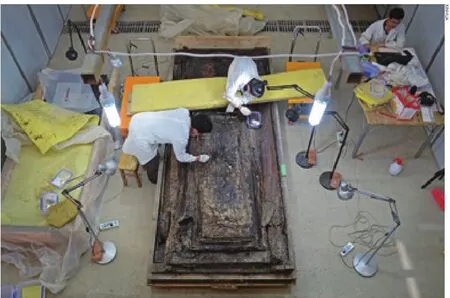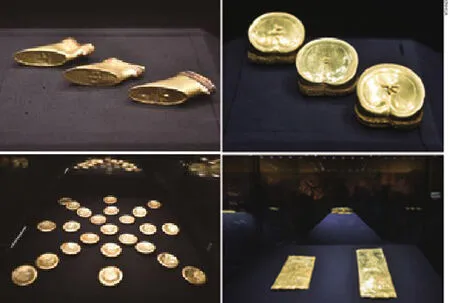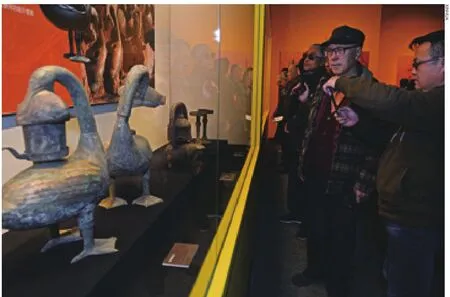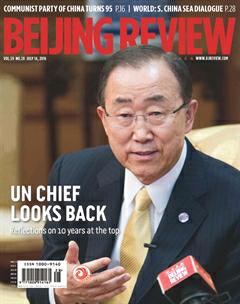Treasure Trove Unveiled
2016-09-22AncientroyaltombilluminatesemperorlifeByJiJing
Ancient royal tomb illuminates emperor's life By Ji Jing
Treasure Trove Unveiled
Ancient royal tomb illuminates emperor's life By Ji Jing

Archaeologists work on the coffn of the Marquis of Haihun on May 4
The discovery of an ancient tomb in a village near Nanchang, capital of east China's Jiangxi Province, in 2011 has brought to light the life of its occupant, Liu He,an emperor in the Western Han Dynasty (206 B.C.-A.D. 25) who was dethroned just 27 days after his accession.
Liu was the grandson of Emperor Wu, the greatest ruler of the Western Han Dynasty, who reigned from 141-87 B.C. Until the discovery,few historical records existed about Liu, whose life could only be pieced together by sporadic paragraphs in historical books such as the offcial chronology known as Book of Han, compiled in the frst century A.D.
Earlier this year, the identity of the tomb's occupant was confirmed by archaeologists,who had found a jade seal bearing the characters Liu He among the human remains at the burial site. The fnding became common knowledge on March 2, when an exhibition of over 400 artifacts from the tomb opened at Beijing's Capital Museum.
The special exhibition, entitled “Splendid Finds,” which continued until June 26, drew over 300,000 visitors. In order to ensure the artifacts' safety, the museum limited the number of daily visitors and required them to make advance reservations.

Gold items discovered from the tomb
Overnight fame
Liu has since become something of a sensation in China. A biography of the emperor, penned by Jiangxi-based author Li Longwu, became a bestseller following its publication in March, selling over 100,000 copies by late May.
Liu, who was King of Changyi, a region in present-day Shandong Province in east China,was chosen as emperor in 74 B.C. by Huo Guang, a top military leader with substantial control over the country at the time.
“Liu was selected because he was young and easy to control,” said Xin Lixiang, a researcher with the National Museum of China, who lead the panel of experts tasked with excavating Liu's tomb.
After ascending to the throne, Liu, 19,indulged himself in merrymaking and was reluctant to attend to state affairs. He was deposed in less than a month.
After his ousting from court, Liu was ordered to return to Changyi. Subsequently, in 63 B.C.,he was banished to today's Jiangxi Province,where he became the first Marquis of Haihun, a geographical region west of present-day Poyang Lake in Jiangxi. But, just four years after movingsouth of the Yangtze River, Liu died in 59 B.C. at the age of 33. Although the cause of his death remains a mystery, some experts postulate that he died from an infectious disease.

Bronze lamps unearthed from the tomb
Objects talk
Liu's life might have remained obscure had his burial site not been accidentally discovered,when tools left by would-be tomb raiders were found by residents of Guanxi Village, who reported the case to local police.
Yang Jun, a researcher with the Jiangxi Provincial Archaeological Research Institute,rushed to the site after hearing about the discovery. Yang thought the tomb might belong to the Marquis of Haihun, as historical documents placed his tomb in the vicinity of the attempted raid.
Since April 2011, the burial site has been thoroughly excavated by Yang and a team primarily made up of staff from the Jiangxi Provincial Archaeological Research Institute. Experts from the Institute of Archaeology of the Chinese Academy of Social Sciences (CASS),Peking University and the National Museum of China also participated in the excavation.
The researchers' efforts unearthed two main tombs, belonging to Liu and his wife, seven tombs of attendants and a chariot burial site. In total, the excavation extended over 40,000 square meters.
Liu's tomb consists of a bedroom and a sitting room, representing in miniature Liu's residence before his death, as well as stores of money, grain, musical instruments, clothing,weapons, cooking utensils and books.
As the most complete and best-preserved royal tomb of the Western Han Dynasty, the site was selected by the CASS in January as one of the six top archaeological discoveries of 2015.
By the end of 2015, over 20,000 artifacts had been excavated, including gold plates,bronze bells and lamps, jade items, lacquer ware, and wooden tablets. And, before Liu's interior coffn was opened in January, nearly 300 gold plates each weighing around 250 grams had been unearthed.
“It's understandable that excavation of treasures like jade and gold attracts more public attention, because they are more impressive visually. Archaeologists, however, are more concerned about finding out history through the digging,” said Yang.
The excavation uncovered various clues pointing to the noble status of the tomb's occupant.
The researchers found 10 bronze dings,vessels used for food that also had ceremonial significance. Burial sites containing nine dings belong to emperors. So, archaeologists have yet to decide on the implication of 10 such vessels.
According to the rituals of Liu's time, three sets of musical instruments indicated a status above the level of Marquis. Yet, two sets of bronze bells and one set of iron bells were found in the tomb.
The five four-horse chariots interred at the site lend further credence to the idea that Liu wanted to underline his noble identity.“Four-horse chariots are the supreme forms of transportation for kings and marquises in the Han Dynasty,” said Xin.
Zhang Zhongli, deputy head of the expert panel and former Director of the Shaanxi Provincial Institute of Archaeology, explained the transgressions by saying that the conventions may not have been strict and the Marquis of Haihun may have bent the rules on purpose to demonstrate his special identity as a former emperor.
Apart from the treasures indicating the occupant's high social rank, the excavation also turned up other interesting items. Yang conjectures that the marquis might have been a foodie, because a bronze hot pot containing chestnuts and other food was found in his burial chamber.
Caterpillar fungus, known for its abilities to treat a number of diseases, was also found in a lacquer box, indicating that the precious herb was used to preserve health in Liu's time.
A website, created using virtual reality technology, launched in late May recreates the Beijing Capital Museum exhibition, displaying artifacts found in the tombs and showing the excavation process.
Authorities will apply for UNESCO World Cultural Heritage status for Liu's burial site, and a theme park and a museum will be built locally to house and display all 20,000 artifacts unearthed from the tomb. ■
Copyedited by Chris Surtees
Comments to jijing@bjreview.com
